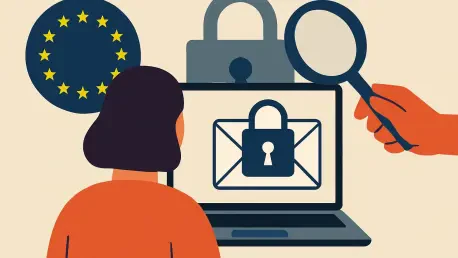Imagine a world where every private message you send is scanned before it even reaches the recipient, all in the name of protecting children from online abuse. This scenario is at the heart of the European Union’s Child Sexual Abuse Regulation (CSAR), often dubbed “Chat Control,” a legislative proposal that has ignited fierce debate across the continent. With the noble aim of curbing child sexual abuse material (CSAM), the regulation mandates the scanning of digital communications, even on encrypted platforms. Yet, it raises a chilling question: at what cost to personal privacy and security? This roundup article gathers diverse opinions, expert insights, and critical perspectives from across the EU to explore whether a balance can be struck between safeguarding the vulnerable and preserving fundamental digital rights.
Exploring the Chat Control Debate: Safety Versus Privacy
The Core Conflict: Protecting Children or Invading Privacy?
The essence of the Chat Control proposal lies in its intent to shield children from online predators by mandating tech platforms to scan private messages for abusive content. Supporters, including several EU member states, argue that the proliferation of CSAM demands drastic measures, even if it means delving into personal communications. Many law enforcement agencies across Europe emphasize that such tools are vital for identifying and stopping perpetrators who exploit digital anonymity.
However, privacy advocates and digital rights groups counter that this approach is akin to mass surveillance, undermining a basic human right. They point out that scanning messages before encryption—known as client-side scanning—essentially breaks the confidentiality of communication. A collective of over 500 cryptography experts recently voiced concerns through an open letter, warning that such measures erode trust in digital systems and set a dangerous precedent for broader monitoring.
This clash of values reveals a deeper divide in how different EU countries perceive the trade-off. Nations with a strong historical emphasis on privacy often lean toward rejecting intrusive policies, while others prioritize immediate safety outcomes. The debate underscores a moral dilemmcan the potential rescue of even a few children justify the surveillance of millions?
Encryption at Risk: Security Implications of Scanning
A significant point of contention is the impact of Chat Control on end-to-end encryption, a technology ensuring that only senders and receivers can access message content. Industry leaders in cybersecurity argue that scanning messages on a user’s device before encryption effectively creates a backdoor, dismantling the very purpose of secure communication. This vulnerability could be exploited not just by authorities but also by malicious actors, posing risks to personal data.
National security bodies in several EU states have echoed these concerns, highlighting that weakened encryption could jeopardize critical infrastructure and expose citizens to cyberattacks from hostile entities. Interestingly, the latest proposal exempts government and military accounts from scanning, a move critics interpret as an acknowledgment of the inherent dangers—yet one applied selectively to the public.
The consensus among tech experts is clear: bypassing encryption for any reason, even a cause as compelling as child protection, opens a Pandora’s box of security threats. This perspective fuels calls for alternative solutions that don’t compromise the foundational safeguards of digital communication.
Diverse Voices on Chat Control: A Roundup of Opinions
Technical Feasibility: Can Scanning Work Effectively?
Turning to the practical side, many tech specialists express skepticism about the reliability of AI-driven scanning tools proposed under Chat Control. They note that current algorithms often produce high rates of false positives, flagging innocent content as abusive, which could overwhelm law enforcement with irrelevant data. This inefficiency raises doubts about whether the system can truly target the right threats.
Another concern is the adaptability of perpetrators. Experts in online safety point out that limiting scans to specific formats like images or URLs might simply push criminals to use other methods, such as encrypted text or alternative platforms. This cat-and-mouse game could render the technology obsolete before it even proves effective, while still infringing on everyone’s privacy.
A smaller faction of technologists suggests that innovation might offer a middle ground, advocating for research into privacy-preserving detection methods. However, they caution that such solutions are not yet viable at scale, leaving the current proposal as a flawed compromise that may fail to deliver on its promises.
Political Perspectives: A Divided EU Landscape
Within the EU Council, opinions on Chat Control are sharply split, reflecting a broader tug-of-war between security and liberty. Representatives from 15 member states currently support the measure, viewing it as a necessary step to combat CSAM, even if invasive. They argue that the urgency of child protection outweighs individual privacy concerns in a digital era rife with hidden dangers.
Conversely, eight countries stand in opposition, prioritizing the preservation of encryption and personal freedoms. Their stance is bolstered by digital rights organizations that warn of a slippery slope toward expansive surveillance, where infrastructure built for CSAM detection could later be repurposed for other forms of monitoring. This fear of mission creep resonates strongly among critics who see the proposal as a gateway to state overreach.
The political deadlock also reveals disparities in trust toward technology and governance across the bloc. Some policymakers question the exemption of official accounts from scanning, seeing it as a double standard that burdens citizens with risks leaders avoid. This divide suggests that consensus remains elusive as the proposal inches closer to a decisive vote.
Key Takeaways from the Chat Control Discussion
Synthesizing the myriad viewpoints, several critical insights emerge from the Chat Control controversy. Child safety remains an undisputed priority, yet the method of mandatory scanning sparks profound disagreement, with privacy advocates and tech experts highlighting the erosion of encryption as a non-negotiable loss. The security risks of creating vulnerabilities in digital systems are a recurring theme, echoed by national defense entities and cybersecurity professionals alike.
On the technical front, the limitations of AI detection tools are a shared concern, with many doubting their ability to accurately identify threats without collateral damage to innocent users. Politically, the EU’s fragmented stance mirrors cultural differences in valuing privacy versus security, complicating the path to a unified policy. These perspectives collectively paint a picture of a well-intentioned but deeply contentious initiative.
For a balanced approach, some stakeholders recommend focusing on user education about secure communication practices, while others urge policymakers to explore non-invasive alternatives like enhanced reporting mechanisms on platforms. Engaging with digital rights campaigns or adopting privacy-focused tools also surfaces as practical advice for citizens navigating this uncertain landscape.
Reflecting on the Path Forward for Digital Rights and Safety
Looking back, the discourse surrounding Chat Control highlighted a profound struggle to reconcile child protection with privacy in the EU’s digital sphere. The varied opinions—from staunch supporters in law enforcement to vehement critics in the tech community—underscored the complexity of crafting policy in an era where technology outpaces regulation. Each perspective added depth to a debate that transcended borders, shaping how society grappled with ethical boundaries.
Moving ahead, actionable steps emerged as vital for progress. Policymakers were encouraged to prioritize research into privacy-preserving technologies that could detect CSAM without breaking encryption. Citizens, meanwhile, found value in staying informed through legislative updates and supporting advocacy groups focused on digital freedoms. Ultimately, the path forward demanded a nuanced strategy—one that safeguarded the vulnerable while fortifying the digital rights that define a free society.









